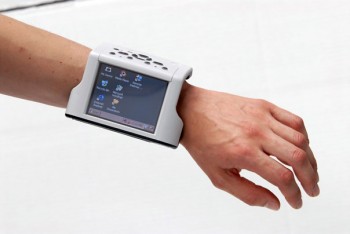Trends via TrendHunter.com.
Ubiquitous / Wearable Computers have been around for quite a while but they have seemed far too fanciful to me. However, i changed my mind the other day when I came across this Becoming Cyborg blog through two other tech blogs. Now, this is a very attractive wearable computer:
 |
| Sleek and comfortable -looking design uses a Beagleboard mini computer and features an iPhone for internet access. |
Evolution of the concept from bulky iPhone display to wearable Unix computer.
But 'wearability' is not why I'm interested in these designs. I wanted to explore ubiquitous computing and natural interfaces. So ultimately, I'm curious about how computers can expand access to information without obscuring interaction with the real world. I'll refer to this as Integrated Personal Computing till I find a better word. Other similar terms you will find are pervasive computing and embedded computing. However, I think pervasive is more closely related to ubiquitous computing in that it refers to computing everywhere and in everything. Whereas, embedded computing would be more pertinent if the computer were somehow implanted or indistinguishable from the user or in the case of microcontrollers and other dedicated processors inside other devices. I feel that integrated personal computers will ultimately be realized as full-featured computers that are inconspicuous and feature natural user input.
Some wearable computers aren't much more so than my BlackBerry. They're both lightweight, can strap to my body, I enter input with my fingers and get output from a display. Advantage of the wearable display is hands-free viewing, which can be incredibly useful in certain situations. Also, when in the field, processing power almost linearly correlates with productivity. I can't take work out in the field if the computer can't run the software that I need or worse, if I end up staring at this half the time:
A few applications of wearable computing:
 |
| Bluntly pragmatic wearable computer |
 |
| Older implementation of a wearable display |
| Military application |
 |
| Emergency Services |
 |
| Telepresence - sort of an odd idea, read the description here |
 |
| Leisure - Gaming? |
 |
| Commercial - Logistics, Inventory management |
 |
| Aircraft maintenance |
Head-mounted displays come in many different shapes and sizes depending on the application. The Myvu brand of head-mounted displays is on par with the sleekest and most lightweight available today. The video below describes how to use a particular head-mounted display which also serves as input for a game.
Another crack at a head-mounted display:
 |
| This blog explains some concerns about wearable computing |
 |
| Eye-Tracking |
 |
| KITTY integrated input device acts as a virtual keyboard |
The iPod Shuffle is a dedicated music player and not in any sense an open-ended computer. However, the speech output of the system is an impressive tool that may find use in other applications as well.
The Zypad, a product of Eurotech is a wrist-wearable computer that claims to be lightweight, ergonomic, yet full-featured. However, if you take a look at the specifications, with a 400mHz processor, 128mb RAM and 4 hours of battery life, you might be better off buying an iPhone 4 with an arm-band and strapping it to your wrist. I like the concept a lot, but the processing power seems dismal for most applications except stripped-down or dedicated software. These devices may possibly be useful in healthcare or for emergency response but they do not seem ruggedized enough to last very long.
 |
| Zypad wearable computer |
 |
| Augmented reality research |
There are many other related technologies which may prove relevant to the advancement of integrated personal computing including flexible displays, health and energy monitoring devices, haptic technology, smart fibers, and swarm robotics among many others.
There is obviously much more to these ideas than is covered in this short exploration of mine. If you want to find out more about integrated personal computing? Check out the blogs listed above and the following sources:
Turns out there might have been a problem with the 'fun' cipher from last week - I think they wrote it down wrong and it turned out making no sense. If you have any ideas, let me know, otherwise, I'll find some other challenge for the next update.




